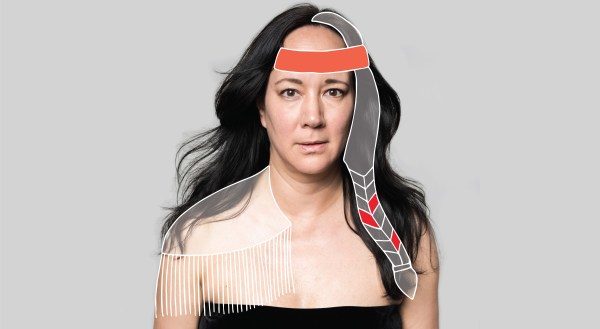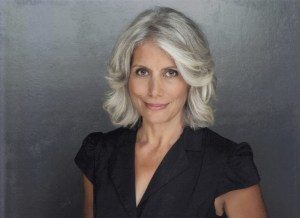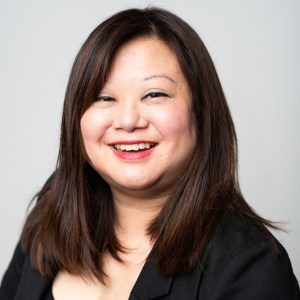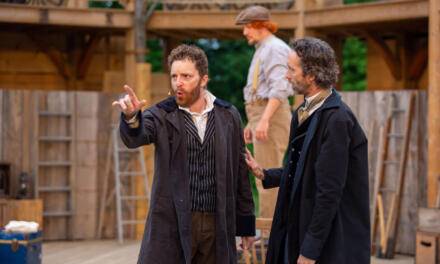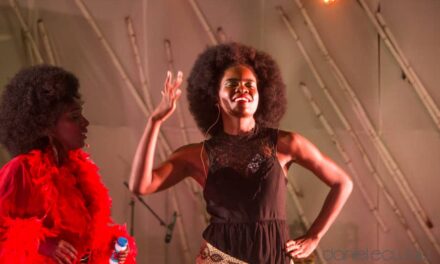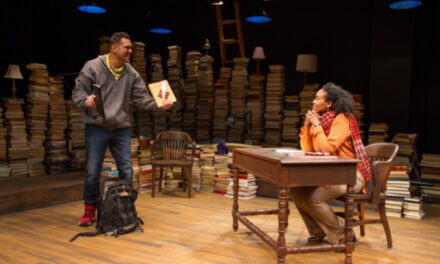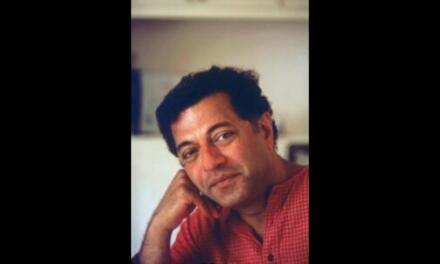Note: Robyn Grant-Moran interviews I Call Myself Princess playwright Jane Lauzon and director Marjorie Chan. I Call Myself Princess is a Cahoots Theatre/Paper Canoe Projects in association with Native Earth Performing Arts. This is the second of three “embedded” posts about I Call Myself Princess – click here for the first post. For more information on embedded criticism, click here.
It’s the day before opening night for I Call Myself Princess, and amidst the pre-show scramble, Jani Lauzon and Majorie Chan have made time to talk to me about the production, opera, theatre, and Indigenous representation. When I arrive, Marjorie Chan is already there, animated and laughing. Jani is at her loom, making some last-minute vamps (the ornate, beaded top of the moccasin shoe) for Marion Newman’s moccasins. It was moccasin mayhem; the original pair weren’t complete, and another pair lost their beads during preview. Marion has her own pair she can wear, so if these don’t get done in time there are options, but Jani is on a mission. Facing all this, she still manages to be a cordial host, bringing snacks and tea, and not once losing her patience with being interviewed while working.
Having stumbled upon the Indianist movement while researching contemporary Indigenous opera myself, I was curious to know how Jani found herself writing a play about Tsianina Redfeather and Charles Wakefield Cadman. The Indianists were composers at the turn of the 20th century, like Cadman, working to create a distinctly (North) American sound, which included the “Indians” that shared the land around them. It turns out that the seed was planted a decade ago when she was working with the Turtles Gals Performance Ensemble. While visiting, Jani found The Only Good Indian: the Hollywood Gospel, the 1972 book by Ralph E. and Natasha A. Friar on their bookshelf.
“What we discovered was that there were hundreds of Indigenous performers, especially in silent film but a lot in opera, a lot in jazz and other kinds of music. And one of the gals who really peaked my interest was Tsianina Redfeather. So, I continued to research her,” says Jani, barely looking up from her loom.
As the Turtle Gals went on to create their own work from their time together, Jani researched Redfeather further and, with “lots of support from Marjorie in terms of development,” I Call Myself Princess began to grow.
“As I Call Myself Princess developed further,” Jani says, “It was important for me to reach out to Tsianina Redfeather’s family. I was able to connect with her great-niece who was named after her. I didn’t get all the family, it was quite large, but I was able to have at least a family liaison.”
Jani reports that Tsianina’s great-niece is happy with how Redfeather’s story is being told.
As Marjorie and Jani tell me more of Redfeather’s history, and of Indigenous performers at the turn of the 20th century, it occurs to me that we’ve been whitewashed relatively recently out of the theatrical world. Jani is working to rectify this: founded in ten years of extensive research by herself and others, including historians and ethnomusicologists, this revised, more accurate history is a history quite different than what kids are taught in public schools. It’s certainly a different narrative than I was taught in university; it’s a history that I would have appreciated as part of my educational experience, and that all students – Indigenous or otherwise – could benefit from.
“Jerod [Impichchaachaaha’ Tate, music director and composer for the show] was telling me the other day about a Cherokee composer around the same time [as Cadman] who actually composed over 500 different compositions. You know?” Jani says. “It’s crazy. It’s insane that we don’t know of any of those works!”
“I think that what is so interesting is the assumption that no one has ever been there,” adds Marjorie, referring to the assumed lack of Indigenous participation. “The opera community still hangs onto a very outdated model. There were Native opera singers 100 years ago right? So that we’re still clinging to [the idea there were none] is absurd because it isn’t even true, right?”
We all chuckle and shake our heads. Jani adds, “One of the interesting things about the argument as to why we’re not represented in that kind of theatre [is] the argument from theatre companies and artistic directors that we weren’t present.”
“Which is not true!” Jani and Marjorie exclaim in unison.
Jani and Marjorie are right; Indigenous opera singers have been present, despite being written out of mainstream opera discourse. In this contemporary setting, we have been doing our best to re-insert ourselves on our own terms. The current understanding of history is part of the complexity of the relationship between Redfeather and Cadman; though it may seem bizarre by today’s standards, their relationship wasn’t entirely exploitative. Redfeather likely believed her people, and their culture, were dying out, and her collaboration with Cadman was a way to save some of her heritage; for his part, Cadman did most likely want to assist in that conservation. Jani points out that the Indianists were “Indigenizing” opera, a tradition taken up by white directors in the 20th and 21st centuries: the Canadian Opera Company did just that with their 1967 and 2017 productions of Harry Somers’ Louis Riel and, in a 2018 production featuring Marion Newman, Victor Davies gave George Ryga’s The Ecstasy of Rita Joe the operatic treatment.
“We think we’ve created ‘Indigenizing,’” Jani says. “‘We’re going to Indigenize this or we’re going to Indigenize that…’ And then I realized that that’s exactly what Tsianina was doing with the opera –we’re just trying to indigenize the American and colonial and Canadian cultures.”
Jani takes it a step further, explaining that she doesn’t use that word–”Indigenize”–anymore.
“I have to come up with a different word because I think it has now a different connotation.”
With that, it all comes back to repairing history and education. With I Call Myself Princess, the audience has a chance to see a more accurate perspective, where history is something that is alive and vibrant for all–not just for lead character William Morin.
“I am hoping, because I also see our youth struggling so much, that somehow we can get them out and get them engaged, and hopefully they can see some of their own struggles within William’s journey,” Jani says. “And to maybe even contemplate that opera is a viable thing!”
Amen, Jani Lauzon and Marjorie Chan.
This article originally appeared in Alt Theatre on September 27, 2018, and has been reposted with permission.
This post was written by the author in their personal capacity.The opinions expressed in this article are the author’s own and do not reflect the view of The Theatre Times, their staff or collaborators.
This post was written by Robyn Grant-Moran.
The views expressed here belong to the author and do not necessarily reflect our views and opinions.

